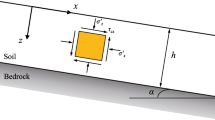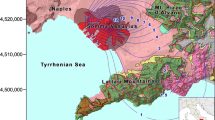Abstract
The zoning of landslide susceptibility on layered landscapes is a key challenge for regional hazard analyses. From a modeling standpoint, the combination of transient infiltration and vertical heterogeneity can lead to hydro-mechanical processes that are difficult to incorporate in spatially distributed frameworks. In this work, a physically based model for the efficient generation of regional landslide susceptibility maps in layered landscapes is presented. The formulation involves the discretization of a digital terrain into slope units, thus enabling the incorporation of georeferenced datasets to define the input variables. Model computations rely on a vectorized finite element (FE) solver that performs simulations of vertical unsaturated flow and slope stability analyses. The framework allows the use of different meshes across the region to efficiently allocate the computational cost associated with layers of variable thickness and/or complex stratigraphy. The model is used to analyze a series of documented shallow landslides that occurred in a region covered by stratified volcanic deposits. In addition to the simulation of layered profiles constrained by field and laboratory data, two simplified scenarios are considered in which homogeneous slopes with different values of hydraulic conductivity Ks are used. It is shown that, while the homogeneous models may have an acceptable spatial performance in some sectors of the landscape, the use of homogenized values of Ks leads to inconsistent temporal sequences of landslide triggering, as well as to failure depths always located at the base of the slope. By contrast, the use of stratified profiles leads to an improved spatiotemporal performance over the whole region, as well as to computed failure depths that are consistent with landslide inventories. The proposed methodology provides a useful tool for landslide hazard studies in that it not only addresses the computational challenges associated with multiple slope stability analyses, but it also enables the incorporation of system properties that are often neglected in spatially distributed modeling frameworks.












Similar content being viewed by others
References
Baum RL, Coe JA, Godt JW, Harp EL, Reid ME, Savage WZ, Schulz WH, Brien DL, Chleborad AF, McKenna JP (2005) Regional landslide-hazard assessment for Seattle, Washington, USA. Landslides 2(4):266–279
Baum RL, Godt JW, and Savage WZ, (2010) Estimating the timing and location of shallow rainfall-induced landslides using a model for transient, unsaturated infiltration: Journal of Geophysical Research: Earth Surface, v. 115, no. F3
Bilotta E, Cascini L, Foresta V, Sorbinow G (2005) Geotechnical characterisation of pyroclastic soils involved in huge flowslides. Geotech Geol Eng 23(4):365–402
Camporese M, Paniconi C, Putti M, Orlandini S (2010) Surface-subsurface flow modeling with path-based runoff routing, boundary condition-based coupling, and assimilation of multisource observation data. Water Resour Res 46(2)
Cascini L, Cuomo S, and Della Sala M (2011) Spatial and temporal occurrence of rainfall-induced shallow landslides of flow type: a case of Sarno-Quindici, Italy: Geomorphology, 126(1):148–158
Cascini L, Cuomo S, Guida D (2008) Typical source areas of May 1998 flow-like mass movements in the Campania region. Southern Italy: Engineering Geology 96(3):107–125
Cascini L, Sorbino G, Cuomo S, Ferlisi S (2014) Seasonal effects of rainfall on the shallow pyroclastic deposits of the Campania region (southern Italy). Landslides 11(5):779–792
Celia MA, Bouloutas ET, Zarba RL (1990) A general mass-conservative numerical solution for the unsaturated flow equation. Water Resour Res 26(7):1483–1496
Chen HX, Zhang LM (2014) A physically-based distributed cell model for predicting regional rainfall-induced shallow slope failures. Eng Geol 176:79–92
Chen Z, Huan G, and Ma Y (2006) Computational methods for multiphase flows in porous media, Siam
Crosta G, Dal Negro P (2003) Observations and modelling of soil slip-debris flow initiation processes in pyroclastic deposits: the Sarno 1998 event. Nat Hazards Earth Syst Sci 3(1/2):53–69
Crozier M (2005) Multiple-occurrence regional landslide events in New Zealand: hazard management issues. Landslides 2(4):247–256
De Vita P, Agrello D, Ambrosino F (2006) Landslide susceptibility assessment in ash-fall pyroclastic deposits surrounding Mount Somma-Vesuvius: application of geophysical surveys for soil thickness mapping. J Appl Geophys 59(2):126–139
De Vita P, Napolitano E, Godt JW, Baum RL (2013) Deterministic estimation of hydrological thresholds for shallow landslide initiation and slope stability models: case study from the Somma-Vesuvius area of southern Italy. Landslides 10(6):713–728
Duncan JM, Wright SG, Brandon TL (2014) Soil strength and slope stability. John Wiley & Sons
Frattini P, Crosta GB, Fusi N, Dal Negro P (2004) Shallow landslides in pyroclastic soils: a distributed modelling approach for hazard assessment. Eng Geol 73(3):277–295
Fredlund D, Morgenstern NR, Widger R (1978) The shear strength of unsaturated soils. Can Geotech J 15(3):313–321
Fressard M, Thiery Y, Maquaire O (2014) Which data for quantitative landslide susceptibility mapping at operational scale? Case study of the Pays d'Auge plateau hillslopes (Normandy, France). Nat Hazards Earth Syst Sci 14:569–588
Godt J, Baum R, Savage W, Salciarini D, Schulz W, Harp E (2008) Transient deterministic shallow landslide modeling: requirements for susceptibility and hazard assessments in a. GIS framework: Eng Geol 102(3):214–226
Guadagno F, Forte R, Revellino P, Fiorillo F, and Focareta M (2005) Some aspects of the initiation of debris avalanches in the Campania Region: the role of morphological slope discontinuities and the development of failure: Geomorphology, v. 66(1):237–254
Iverson RM (2000) Landslide triggering by rain infiltration. Water Resour Res 36(7):1897–1910
Lizárraga JJ, Frattini P, Crosta GB, Buscarnera G (2017) Regional-scale modelling of shallow landslides with different initiation mechanisms: sliding versus liquefaction. Eng Geol 228:346–356
Lu N, Godt J (2008) Infinite slope stability under steady unsaturated seepage conditions. Water Resour Res 44(11)
Mancarella D, Doglioni A, Simeone V (2012) On capillary barrier effects and debris slide triggering in unsaturated layered covers. Eng Geol 147:14–27
Montgomery DR, Dietrich WE (1994) A physically based model for the topographic control on shallow landsliding. Water Resour Res 30(4):1153–1171
Pirone M, Papa R, Nicotera MV, Urciuoli G (2015) In situ monitoring of the groundwater field in an unsaturated pyroclastic slope for slope stability evaluation. Landslides 12(2):259–276
Richards LA (1931) Capillary conduction of liquids through porous mediums. Physics 1(5):318–333
Sorbino, G., & Foresta, V. (2002). Unsaturated hydraulic characteristics of pyroclastic soils. In Proceedings of the 3rd international conference on unsaturated soils (Vol. 1, pp. 405–410). Rotterdam, the Netherlands: Balkema
Sorbino G, Nicotera MV (2013) Unsaturated soil mechanics in rainfall-induced flow landslides. Eng Geol 165:105–132
Sorbino G, Sica C, Cascini L (2010) Susceptibility analysis of shallow landslides source areas using physically based models. Nat Hazards 53(2):313–332
Van Dam JC, Feddes RA (2000) Numerical simulation of infiltration, evaporation and shallow groundwater levels with the Richards equation. J Hydrol 233(1–4):72–85
Van Westen C, Van Asch TW, Soeters R (2006) Landslide hazard and risk zonation—why is it still so difficult? Bull Eng Geol Environ 65(2):167–184
Van Westen CJ, Castellanos E, Kuriakose SL (2008) Spatial data for landslide susceptibility, hazard, and vulnerability assessment: an overview. Eng Geol 102(3–4):112–131
Zhu J (2008) Equivalent parallel and perpendicular unsaturated hydraulic conductivities: arithmetic mean or harmonic mean? Soil Sci Soc Am J 72(5):1226–1233
Zienkiewicz, O. C., Chan, A., Pastor, M., Schrefler, B., and Shiomi, T., 1999, Computational geomechanics, Citeseer
Funding
This work was supported by Grant No. CMMI-1324834 awarded by the US National Science Foundation.
Author information
Authors and Affiliations
Corresponding author
Rights and permissions
About this article
Cite this article
Lizárraga, J.J., Buscarnera, G. Spatially distributed modeling of rainfall-induced landslides in shallow layered slopes. Landslides 16, 253–263 (2019). https://doi.org/10.1007/s10346-018-1088-8
Received:
Accepted:
Published:
Issue Date:
DOI: https://doi.org/10.1007/s10346-018-1088-8




